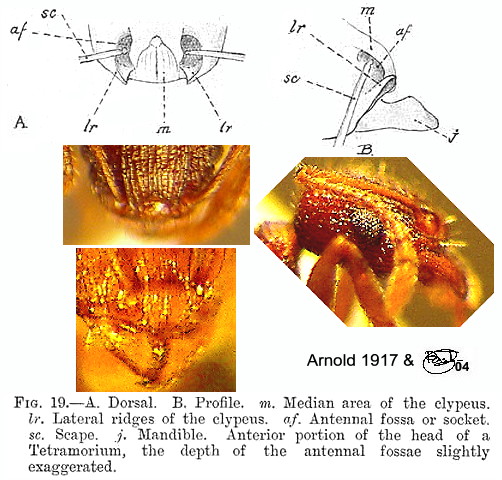SUBFAMILY MYRMICINAE - Genus Tetramorium Mayr
| The Ants
of Egypt SUBFAMILY MYRMICINAE - Genus Tetramorium Mayr |

Genus Tetramorium Mayr (1855: 423), includes previous Macromischoides, Triglyphothrix and XiphomyrmexIn Tribe TETRAMORIINI. Synonymy of former genera by (Bolton, 1976, 1980, 1985). Diagnostic Features - Antennae 11- or 12-segmented, with a 3-segmented club. Antennal scrobes absent to feebly present; frontal carinae often extended as a pair of diverging longitudinal rugae. Mandibles with three or four large teeth apically, followed by a variable number of denticulae. Posterior lateral margins of clypeus raised into a ridge bordering the antennal insertions (see image, right, adapted from Arnold, 1917: 272, and my own photography). Pronotum characteristically square-shouldered in dorsal view due to the sharp anterolateral angles. Promesonotal suture absent; metanotal groove usually impressed. Propodeum with a pair of spines or teeth; metapleural lobes present, acute, and may project as a lower pair of spines. Sting with an apicodorsal lamelliform appendage. Femora usually distinctly swollen. Mayr (1861: 61) reiterated his earlier (1855) genus
description, this is at Erect hairs simple in most species, but divided in many former Triglyphothrix, and bizarre in a few species. The former Macromischoides (or at least African members) do not have the posterior lateral margins of the clypeus raised into a ridge bordering the antennal insertions; are less noticeably square-shouldered; and have a more rounded shape to the head in full face view, plus antennal scapes which surpass the occipital margin. Finzi (1936) provided a key to species from Egypt, this is at |
|||||||||||||||||||||||||||||||||||||||||||||||||||||||||||||||||||||||||||
|
Speculative Key to Workers from Egypt
|
|
©2005, 2006, 2008, 2009, 2010,
2015 - Brian Taylor CBiol FRSB
FRES 11, Grazingfield, Wilford, Nottingham, NG11 7FN, U.K. |
href="tetramorium.htm"